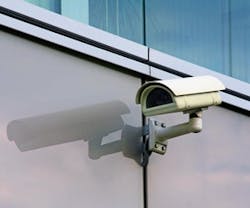Security: Emerging Design Trends
The security standard of care continues to evolve across every infrastructure, with technology playing a more important role than ever before. In today’s security-conscious environment, architects need to know more about the latest technologies and trends, and how they might fit into their designs.
Building Perimeter Control
For any traditionally open and unrestricted environment, closing access to facilities during an emergency or security incident has been very difficult. Designers have been struggling with the inability to lock down a building or series of buildings quickly when necessary. Some still use antiquated phone trees, relying on landlines to instruct users to manually lock access doors, one building at a time. Once the all-clear decision is made, an equally tedious reverse process is required to return facilities to their normal state. Procedures like this are brutally inefficient, and may unnecessarily introduce staff into harm’s way.
The design trend at new facilities is to shun traditional locks around the building perimeter and use electrified locks connected to a centralized system. Perimeter doors can be anywhere – from the basement, up to the third floor or beyond – depending on elevation, exterior stairs, or connection to nearby structures. When these perimeter door locks are connected to an access-control system, an authorized person could initiate “one-click” locking of a building or series of buildings at the touch of a button, within seconds. Some are moving toward the “keyless facility,” with electronic locks and proximity/smart cards to exclusively control access. A proximity card system isn’t necessarily required to accomplish remote lockdown capability, but moving to an electronic card might also reduce or eliminate systemic manual key control issues while giving security personnel a critical tool in their incident response toolkit.
Mass Notification
Keeping everyone informed in a crisis and maintaining a sense of order are appropriately high on everyone’s list of important issues. Here again, the industry rush for solutions has overshadowed some of the reality and limitations of some of these technology-interdependent applications. E-mail and text messaging are so engrained into our daily lives that their application as universal saviors in a crisis seems to be sound judgment. Real-world realities have demonstrated fundamental flaws in the design of an approach relying on only one or two notification technologies. The logistics of maintaining massive distribution lists has proven to be a bigger challenge than anticipated. Sending tens of thousands of e-mails and/or text messages at once has overwhelmed systems and caused embarrassing delays. In some cases, alerts have been received many hours after an incident’s conclusion, and after media reporting has occurred. Fundamental misperceptions about what systems are capable of doing are still a regular occurrence, sometimes resulting in an incomplete emergency-notification strategy and unfulfilled needs.
Designers of notification systems should take advantage of the lessons learned by early technology adopters. The clear trend is to focus on a multi-mode system strategy that incorporates high-tech, low-tech, and no-tech solutions. While text messaging still remains an important component of an alert program, comprehensive solutions now include radio, television, audio paging, instant messaging, phone calls, digital message boards, improved continuous-awareness training, and old-fashioned emergency lights and sirens.
One emerging technology that should ease the performance problems associated with cell phone messaging is “cellular broadcasting.” Instead of acquiring and maintaining massive user lists, cellular broadcasting allows someone to transmit a message simultaneously to anyone near a particular cell tower. This technology greatly reduces drain on network resources, which results in significantly increased performance and system effectiveness.
Intelligent Video Analytics
Intelligent video analytics are finally realizing their promise. Effectively enhancing the eyes and ears of increasingly limited security resources with these advanced video systems is becoming a viable reality. For many years, we’ve heard the promises, seen the tradeshow demonstrations, and, in some cases, deployed Beta systems to gauge the security and safety enhancement possibilities of these systems. Unfortunately, the promises didn’t justify the hype. Initially, these military-rooted, processor-heavy applications were designed for government entities not concerned about price, complexity, or false-alarm rates, and came with more than their share of challenges. Expensive, difficult-to-maintain systems, combined with well-publicized failures, seemed to do more harm than good, and set an unfortunate perception about the viability of video analytics. Rightfully, security designers became increasingly cautious about these systems.
Thankfully, healthy competition has finally resulted in significantly lower prices. Manufacturers have applied lessons learned over a number of product generations to improve the accuracy and functionality of their products. Systems now offer many more à la carte options to suit a particular application, and clients are no longer forced into a bundled suite of rules at a higher cost. Cameras can now be ordered with specific features built directly into them at the factory. Systems now come with easier-to-use learning modes and masking features to facilitate better system tuning, which reduces nuisance and false alarms to a manageable level. Applying video analytics is now much less costly, easier to deploy, offers better condition adaptive “learning,” and requires much less processing power to function. Analytics systems that, not long ago, cost $3,000 to $5,000 per camera while using intense server processing resources can now achieve many of the most essential features for a few hundred dollars per camera (or less). Designers are proactively using video analytics to extend the reach of public safety staff in areas where undesired activities might occur.
It remains critical that architects pay closer attention to these and other security considerations. Remain mindful that your decisions materially impact the effectiveness of the security program throughout the lifespan of the project.
James R. Black, CPP, PSP, CSC, CET, serves as senior security consultant for TRC Solutions. Black is a member of ASIS and the International Association of Professional Security Consultants. He holds numerous security licenses and regularly writes and lectures about current and emerging security technologies. Black can be reached at [email protected].
